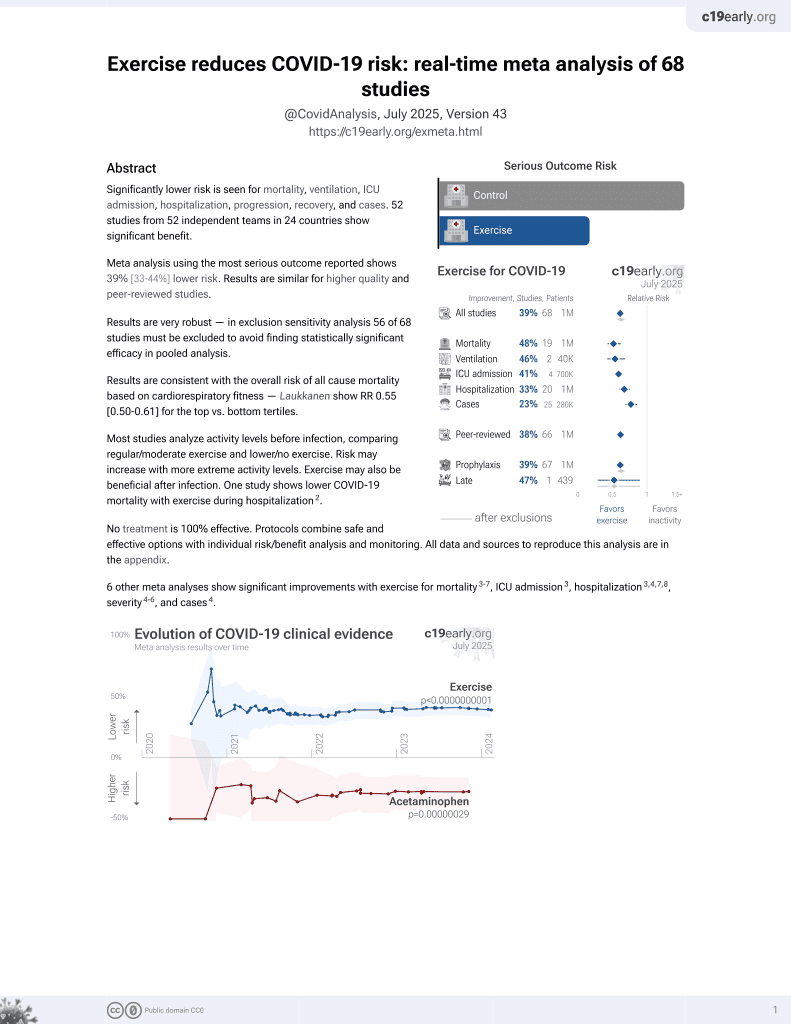
Influence of the Level of Physical Activity on Symptoms and Duration of Recovery From Covid-19
et al., Sports Science and Health, doi:10.7251/SSH2301078S, Jul 2023
Exercise for COVID-19
9th treatment shown to reduce risk in
October 2020, now with p < 0.00000000001 from 68 studies.
No treatment is 100% effective. Protocols
combine treatments.
6,300+ studies for
210+ treatments. c19early.org
|
Retrospective 100 COVID-19 patients in Bosnia and Herzegovina, showing lower symptom severity and faster recovery with a history of regular physical activity.
|
risk of oxygen therapy, 89.5% lower, RR 0.11, p = 0.045, high activity levels 0 of 53 (0.0%), low activity levels 4 of 47 (8.5%), NNT 12, relative risk is not 0 because of continuity correction due to zero events (with reciprocal of the contrasting arm).
|
|
risk of hospitalization, 91.4% lower, RR 0.09, p = 0.02, high activity levels 0 of 53 (0.0%), low activity levels 5 of 47 (10.6%), NNT 9.4, relative risk is not 0 because of continuity correction due to zero events (with reciprocal of the contrasting arm).
|
|
risk of progression, 83.9% lower, RR 0.16, p < 0.001, high activity levels 4 of 53 (7.5%), low activity levels 22 of 47 (46.8%), NNT 2.5, pneumonia.
|
|
no recovery, 47.3% lower, RR 0.53, p < 0.001, high activity levels 22 of 53 (41.5%), low activity levels 37 of 47 (78.7%), NNT 2.7, day 14.
|
| Effect extraction follows pre-specified rules prioritizing more serious outcomes. Submit updates |
Šebić et al., 15 Jul 2023, retrospective, Bosnia and Herzegovina, peer-reviewed, 5 authors.
Abstract: https://doi.org/10.7251/SSH2301078S
Original scientific paper
UDC: 616.98:578.834]:612.766.1
Originalni naučni rad
Influence of the Level Utjecaj nivoa tjelesne
of Physical Activity on aktivnosti na simptome i
Symptoms and Duration of trajanje oporavka od bolesti
Recovery From Covid-19 Covid 19
Lejla Šebić, Alma Suhonić, Erol Kovačević, Nedim Čović, Izet Bajramović
Faculty of Sport and Physical Education, University of Sarajevo,
Bosnia and Herzegovina
Fakultet sporta i tjelesnog odgoja, Univerzitet u Sarajevu, Bosna i
Hercegovina
Correspondence:
Lejla Šebić
Faculty of Sport and Physical Education; University of Sarajevo,
Bosnia and Herzegovina
lejla.sebic@fasto.unsa.ba
Korespondencija:
Lejla Šebić
Fakultet sporta i tjelesnog odgoja, Univerzitet u Sarajevu, Bosna i
Hercegovina
lejla.sebic@fasto.unsa.ba
Abstract: Insufficient physical activity and seden-
tary lifestyle have exposed most of the population with
chronicle diseases, to higher risk of infection of COVID-19, with extremely severe consequences and exhausting and long recovery after the illness. Regular
physical activity, as one way of prevention and faster
recovery from COVID-19, is an important priority for
improvement health and quality of life in people. The
aim of this paper is to determine the connection between regular physical activity of the population with
the presence of symptoms and duration of recovery from
COVID-19. Total number of subjects was 100 people of
both genders (male 32 and female 68) of younger age
(age: 30-44) without existing chronicle diseases and
healed from COVID. Data of regularity of exercising,
symptoms, and recovery period were obtained by survey
of this study: Active group of subjects (A=53) in continuity at least 3 months, two times a week, 60 minutes
and Inactive group (N=47), who never exercised, nor
they are physically active. Chi-square test was used (χ2
test differences between groups), to determine differences of extensive frequencies. Results of the research
showed that there are statistically significant differences between two groups (p<0.001) on the behalf of group
with active subjects, in terms of severity of symptoms
of COVID-19 and their recovery lasted shorter than
in inactive group of subjects. Study shows that regular
physical exercise has significant impact on human body
and is important factor of enhancing immune system,
which enables faster recovery and easier dealing with
symptoms of COVID-19.
Keywords: health, physical exercising, Coronavirus,
COVID-19. recovery, symptoms.
78
Apstrakt: Nedovoljna tjelesna aktivnost i sedentarni način života su veliki dio populacije sa hroničnim bolestima
izložili puno većem riziku obolijevanja od COVID-19 sa
izuzetno teškim posljedicama po zdravlje, kao i dugotrajnijim iscrpljujućim oporavkom nakon bolesti. Redovna
tjelesna aktivnost kao jedan od načina prevencije i bržeg
oporavka od bolesti COVID-19 predstavlja važan prioritet
unapređenja zdravlja i kvalitete života ljudi. Cilj rada je
bio utvrditi povezanost redovne tjelesne aktivnosti stanovništva sa prisustvom simptoma i vremenom oporavka od
COVID-19. Ukupan broj ispitanika za ovo istraživanje je
činilo 100 osoba, oba spola (muškarci=32, žene=68) mlađe
životne dobi (age: 30-44 godine), bez postojećih hroničnih
bolesti, a prebolovale su COVID-19. Podaci o redovnosti
vježbanja, simptomima i vremenu koje je bilo potrebno za
oporavak, dobivene su na osnovu anketnog upitnika osmišljenog za potrebe ovog istraživanja. Ispitanici su na..
